Goals of Lecture 1:
1. Describe what this course is about, and how we'll do it.
2. Describe the scientific methods
3. Describe the characteristics of life and the importance of evolution in explaining life's other attributes.
I. Course Overview:
Welcome to Biology 111: Foundations of Biology. This course is designed for students pursuing a B. S. degree, or for those pursuing another career where a "major's" course in Biology is required. Two other courses, BIO 101 and BIO 102, are also "lab-based" classes, but they are designed for non-science students. Non-science students are welcome in BIO 111 also, but there are a couple differences between these classes. First, BIO 111 is a bit more quantitative than the other classes. We will collect quantitative data, analyze the data with statistical tests, and use math throughout the course. Second, the other classes are "self-contained"; they are designed, in many ways, to be the last biology class someone might take. BIO 111 is "foundational". Like all other introductory courses in other majors, the course is designed to provide the grounding needed to succeed in additional biology courses.
This course (as well as BIO 101 and 102) earns General Education credit in the "Empirical Studies of the Natural World with lab" category. There will be weekly quizzes, cumulative exams, and a cumulative final exam. There will be labs and lab write-ups. The dates and point values of these assignments are described in the syllabus.
So, now that we are sure we are in the right place, let's begin.
II. The Science of Life:
A. What is Biology?
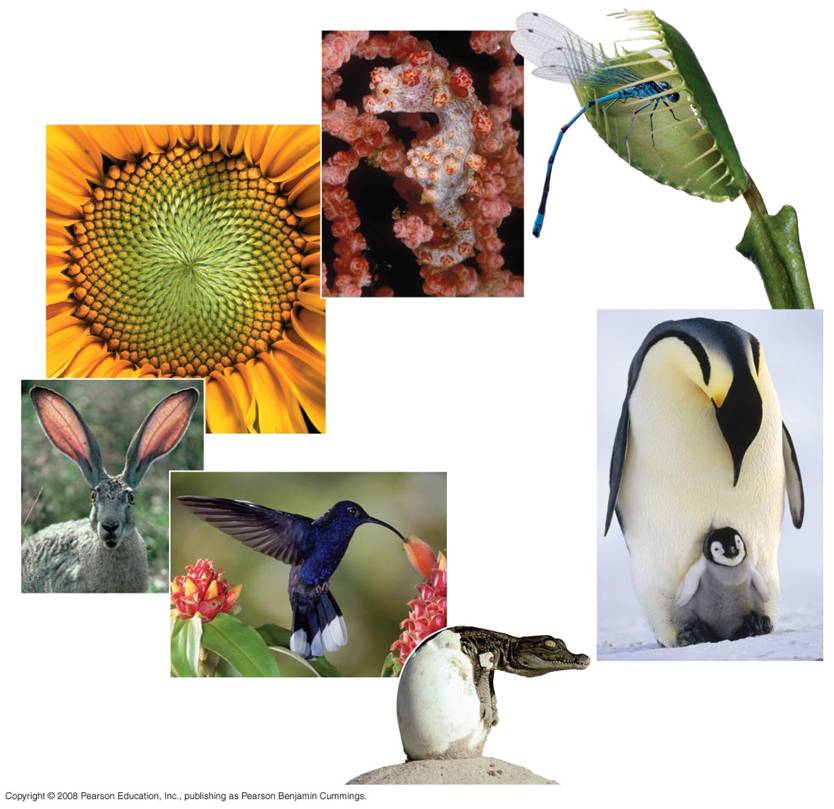
Webster's
New World Dictionary defines biology as, "the science that deals with the
origin, history, physical characteristics, life processes, habits, etc. of plants
and animals: it includes botany
and zoology." Actually, this is horrible definition! First, it seems to limit
the study of biology to only plants or animals...what about bacteria, protists,
and fungi? Second, although it refers to "physical characteristics"
(which could be cellular) and "habits" (which could be ecological),
there seems to be an implication that biology is the study of plant and animal
organisms. Actually, Biology studies living systems - from the cellular
to ecosystem and biospheric levels. Indeed, biochemists, molecular biologists,
and geneticists also study the non-living components that make up cells.
- Our definition: "biology is the scientific study of living
systems".
- This begs two questions: What is
science and what is life?
1. What is science? Webster's: "systematized knowledge
derived from observation, study, and experimentation carried on in order to determine
the nature or principles of what is being studied. The systematized knowledge
of nature and the physical world". So, science is limited - it is limited to studying the PHYSICAL WORLD (UNIVERSE), through EXPERIMENTATION. That will be our definition: "science is the study of the physical universe through experimentation."
Science is limited to studying the physical universe; it is unable to address
questions of morality ("Is killing ever justified?"), or those dependent on the assumed existence of supernatural
agents ("Where does God live?"). However, facts drawn from science and from nature may have implications
in these areas. The physical universe is a pretty big and complex place; how
can we even begin to try and understand this seemingly limitless complexity?
Where do we begin and how do we proceed?
Science is an empirical philosophical approach, meaning that a scientific argument
or "truth claim" requires physical evidence that can be experienced
"by the senses". But science is much more than "common sense"
- in fact, it is almost the exact opposite. "Common sense" is a conclusion
or "truth claim" that is accepted based on personal observation or
opinion, alone--without thoughtful reflection or consideration of other alternatives.
So, "common sense" would tell us that the Earth is flat, the sun orbits
the Earth, solids are mostly matter (not space, as they are), and species are
unrelated. By it's very nature, science does the opposite; it necessarily creates
testable hypotheses that addresses at least one more important alternative--your
idea might be wrong. Science tries hard to exclude personal opinion or bias
in reaching a conclusion. That is why science is so quantitative and mathematical;
numbers are impersonal and are less subject to opinion. So, the goal of science
is to explain observations by testing falsifiable hypotheses of causality. "Testing"
means gathering new physical evidence that bears on this question. Over time,
scientists have found that FOUR major philosophical approaches have been very
useful in describing the universe. None are unique to scientific study, but
together they make a very powerful tool for understanding the physical universe.
a. REDUCTIONISM:
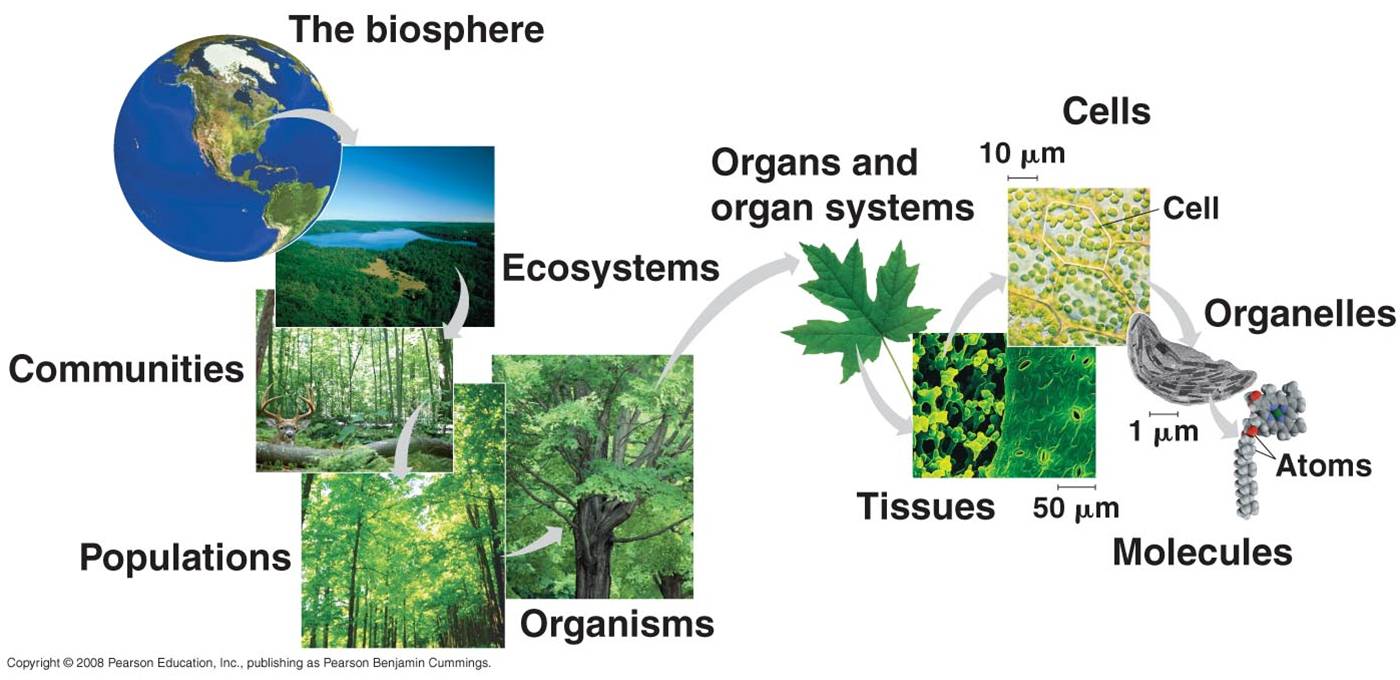
If you have a complex system (and
all living systems are very complex), and you want to figure out how it works,
try to 'break it down' into smaller, less complex subsystems. If you can figure
out how the subsystems work, maybe you can then appreciate how the subsystems
relate together to function as the cohesive whole. Consider a cell; it takes
in material, break that stuff down and harvests the energy released by this
breakdown, then uses that energy to maintain its own integrity (replacing broken
stuff), and build new stuff (grow and reproduce). It is all incredibly complex,
but maybe we can get a handle on how it all happens by looking at one step at
a time.... even by looking at the structure and characteristics of what cells
are made of - that's what we'll do in the first part of the course. However,
it is important to appreciate that parts interact in a system; so knowing everything
about the parts may not give you a complete understanding of the how the whole
system behaves. In medicine, anatomy is important - but it does not explain
all of physiology. In natural history, taxonomy is important - but it doesn't
explain how the species interact. In genetics, we have sequenced the whole genome,
and may eventually identify all of the genes in humans...but this will not allow
us to completely describe how the genes all interact to form a functional genome.
Properties that arise at each level of organization that cannot be explained
by the action of subsystems are called 'emergent properties'.
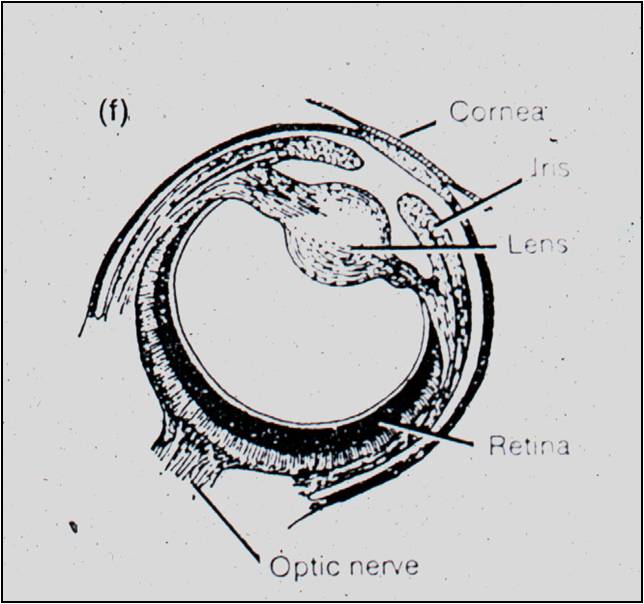 Another example is the "camera eye". It is an
extraordinary organ. How does it work? Well, break it down.
There is a retina that responds to visible light by sending neural impulses
to the brain. There is a lens that focuses light on the retina.
There is an iris that regulates the amount of light entering the eye.
There is a cornea that bends the light initially, and there are two gelatinous
"humors" that give the eye shape. WOW! It is a complex system, but
by breaking it down into its component subsystems and learning what they do,
we describe--in part--how an eye works.
Another example is the "camera eye". It is an
extraordinary organ. How does it work? Well, break it down.
There is a retina that responds to visible light by sending neural impulses
to the brain. There is a lens that focuses light on the retina.
There is an iris that regulates the amount of light entering the eye.
There is a cornea that bends the light initially, and there are two gelatinous
"humors" that give the eye shape. WOW! It is a complex system, but
by breaking it down into its component subsystems and learning what they do,
we describe--in part--how an eye works.
b. THE COMPARATIVE METHOD:
When any complex system is considered in isolation,
the observer is impressed with its complexity, integration of function, and
internal causalities, and the very complexity of it seems to make figuring out
it's origin nearly impossible. When we ask "why an eye?" or even the more mundane
question of "How an eye?", there seems to be no place to start.
Here's where the comparative methods finally comes into play, particularly within
biology and the context provided by evolution. If we hypothesize that eyes evolved
from simpler structures, maybe we can COMPARE the camera eye to the visual structures
used by simpler, more primitive groups. We know they function, so by definition,
these primitive systems are internally plausible and evidentiarily true - they
exist, they aren't hypothetical constructs. So,let's compare the'eyes' in molluscs....
from limpets to snails to nautiloids to squid.
Hmmm.... retina first, lens second, humours third, cornea and muscles last.
Functionally efficient at each step, satisfying the limitations of a functional
non-random sequential process. Good answer to an initally apparently intractible,
unanswerable question using reductionism and the comparative method in an evolutionary
context. We'll see this argument play out again tomorrow.
The comparative method is a very powerful tool
in biology, because there is a REASON that organisms might be similar in structure
or function. That reason is common ancestry
- all species share a common ancestor with one another. The more recent that
ancestor is, the more genes the species share and the more similar we might
expect them to be. Even organisms that are very different - like flies and humans
- can trace their separate lineages back to a common ancestor - probably a very
primitive bilaterally symmetrical animal of the pre-cambrian, 600 million years
ago. Although flies and humans are very different, they share the same basic
stages of animal development from a zygote through to the establishment of a
bilateral embryo. And indeed, they share the genes that co-ordinate this early
development, the establishment of a head and tail end, and cues to specify how
intervening body regions will develop. This common ancestry, and this similarity
in structure and function, is the basis for our ability to use other species
as models for humans - we learn about human genetics by studying flies, and
we learn about human disease by studying mice.
c. EXPERIMENTATION:
Finally, the most direct way to tease apart causality from a nearly infinite
set of coincident events is experimentation. For instance, if you want to know
how eyes develop, well, there are an infinite set of events occuring whe an
eye is developing, including genetic events and environmental events.
1) The first element is REPLICATED OBSERVATION - you have to observe something
alot of times to get a feel for which events happen concurrently and might be
putative causal agents. For instance, you might be watching the development
of a fruit fly and you might notice that the eye begins development on a rainy
day. Well, did rain cause eye development? NO WAY TO TELL. But, if you observe
eye development in 100 flies over a period of time, you will probably notice
that eye development occurs on rainy AND sunny days, so neither rain nor sun
correlates with eye development and thus are probably not causal agents. Through
careful observation and some knowledge of the system, a subset of factors possibly responsible can be determined. So, observation does
not invovle looking at ONE thing - it involves looking at MANY THINGS and observing
patterns of correlation among these things. Where to from here?
2) The second step is to construct a HYPOTHESIS; a statement of causal relationship.
What is actually causing the phenomenon that you observed?
For a hypothesis to be scientific, it must be falsifiable with evidence from the
physical world. You see, science is NOT the process of dreaming up ideas
and then only seeking data that confirms this idea. The fundamental process of science is testing falsifiable hypotheses. What
does this mean? Well, a falsifiable hypothesis is
one that could be proven false—it is a statement for which you can
envision contradictory evidence. For example, the
statement that “humans evolved from other primates” is a falsifable statement.
We can envision collecting data that would disprove it.
If, for example, we found human fossils DEEPER in sedimentary deposits
than any other primates, then this would suggest that humans lived before all
other primates and thus could NOT be descended from other primates. We TEST hypotheses by looking for BOTH contradictory and
supporting evidence in an unbiased way. So, we dig
deeper into sedimentary strata in places we haven’t dug yet.
We don’t know what is there, so it is an unbiased search.
We could find human fossils (which would disprove the hypothesis), or
we could find only other primates (which would support our hypothesis). The KEY is that, in an experiment, both falsification
and support is possible. In this way, questions about the past are testable,
too; not just things that are happening today.
Hypotheses are either supported or rejected by the experiment. When multiple results converge on a single explanation, that explanation, that explains all the existing patterns and makes PREDICTIONS about other patterns, is called a THEORY. So, the word "theory" in science does NOT mean "untested idea". We have a differnt word for that, remeber? (Hypothesis). Rather, "theory" means a broad, TESTED, explanatory model of how the physical universe works. They are supported by previous tests. They are used to make predictions of subsequent events in the physical world. But they are incomplete; they can be modified to become more precise. Consider these THEORIES in science:
Physics: Atomic Theory (until THIS YEAR, no one has seen an atom, but this theory explains how matter
behaves)
Astronomy: Heliocentric Theory (no one has stood outside the solar system, but this model
predicts where the planets will be in relation to each other and the sun.)
Chemistry: Bond Theory (until 2009, no one has seen atoms bound together as molecules, but this theory predicts
which the binding properties of chemicals)
Biology: Evolutionary Theory (no one has seen a living dinosaur, but morphological, paleontological,
geological points to a relationship with birds, and this predicts where subsequent
fossils are found).
d. METHODOLOGICAL MATERIALISM:
You
can only manipulate and observe physical phenomena. So, because science is limited
to the study of physical, material phenomena, hypotheses regarding non-physical,
non-material, or supernatural things are beyond the bounds of science, can not
be addressed by scientific methodologies, and so are not scientific hypotheses.
Now, this is a methodological limitation. Science does not (and methodologically
can not) assert that the physical/material universe is all there is. This would
be philosophical materialism. But, the physical is all that can be tested by
science.
2. What is life?
Living
systems are not distinguished from non-living systems by one single characteristic.
Chemical reactions are not unique to living systems; reproduction is not unique
to living systems; even evolution is not unique to living systems - computer
programmers have created algorithms that introduce variation into replicated
algorithms and select from this pool based upon some production/efficiency criterion.
But, life IS distinguished by expressing a suite of characteristics together.
And, since life is such a rollicking good time, you might remember these characteristics
by remembering that life is a "CELLULAR O-R-R-G-E-E".
- CELLULAR. All living things are composed of cells. So, from a reductionist perspective, we can learn a lot about how and why life does what it does by understanding how cells work. For example, you breathe in oxygen because your cells use it. You breathe out carbon dioxide because your cells produced this as a waste product of metabolism. So, an action at the organism level (respiration) can really ONLY be understood by understanding how cells work. Even at the level of the entire biosphere, cellular metaboism is important. Plants and other photosynthetic organisms absorb carbon dioxide and make sugars with it. they take carbon dioxide out of the air. So, the more plants there are, the more carbon dioxide is taken out of the atmosphere. And unfortunately, the reverse is also true; the more forests that are cut down, the more carbon dioxide remains in the atmosphere to heat our planet. So, even PLANETARY PROCESSES are driven by cellular metabolism.
– ORGANIZATION. All living systems,
from a cell to the biosphere, are highly complex, non-random systems. How is
this order created and maintained? I'm sure you are familiar with the dictum
that "entropy increases". In short, this means that, in a closed system
that is not exchanging energy or matter with other systems, energy that can
be used for work will decrease over time and any 'orderliness' in the system
will decay. The key here is that living systems are NOT closed systems. They
are open systems that can achieve greater order through harvesting more energy
or using energy inputs with greater efficiency. This does not violate the second
law of thermodynamics... (uh, it can't, cuz that's a LAW). The second law stipulates
that no energy transformation is 100% efficient - so, when a transformation
occurs, some energy is 'lost' ... usually as heat. So, as transformations proceed,
the tendancy will be for useful energy to decline in the system, as it is transformed
with less than 100% efficiency. So, how can living systems maintain their complexity
in the face of this tendancy for energy to erode? They simply take in more than
they are losing to entropy. You radiate huge amounts of heat energy from your
body, representing energy lost through the inefficient metabolism of food and
the inefficient conversion of chemical energy (food) to mechanical energy (movement).
You are an entropy MACHINE, rapidly converting lots of high energy stuff into
heat! How can this continue? Well, stop eating, drinking, and breathing and
it won't. Although energy is pouring out of you, you can actually increase your
energy content and complexity (creating more cells) by taking IN more energy
than you are losing entropically.
Order
and organization occur at many different heirarchical scales of biological and
material organization. The reductionistic approach has allowed us to describe
the structure at these different levels; at each level, new energent properties
are expressed as a consequence of interactions between components.
Know the order of these scales:
atom<molecule<organelle<cell<tissue<organ<organ system<organism<population<species<community<ecosystem.
- REPRODUCTION - Living systems reproduce - making copies of themselves. However, other non-living things reproduce, also,
in a manner of speaking. A rock that is split is now two rocks, for instance.
Some organisms reproduce in much the same way - simply by splitting or fragmenting.
This type of reproduction does not create a new set of genes, however. This is called 'asexual' reproduction.
In sexual reproduction, new combinations of genes are created. As a consequence
of the inexact/incomplete transfer of genes through time from one generation
to the next, heirarchical patterns of genetic relatedness are created within
families (genealogy) and among species (phylogeny) over time.
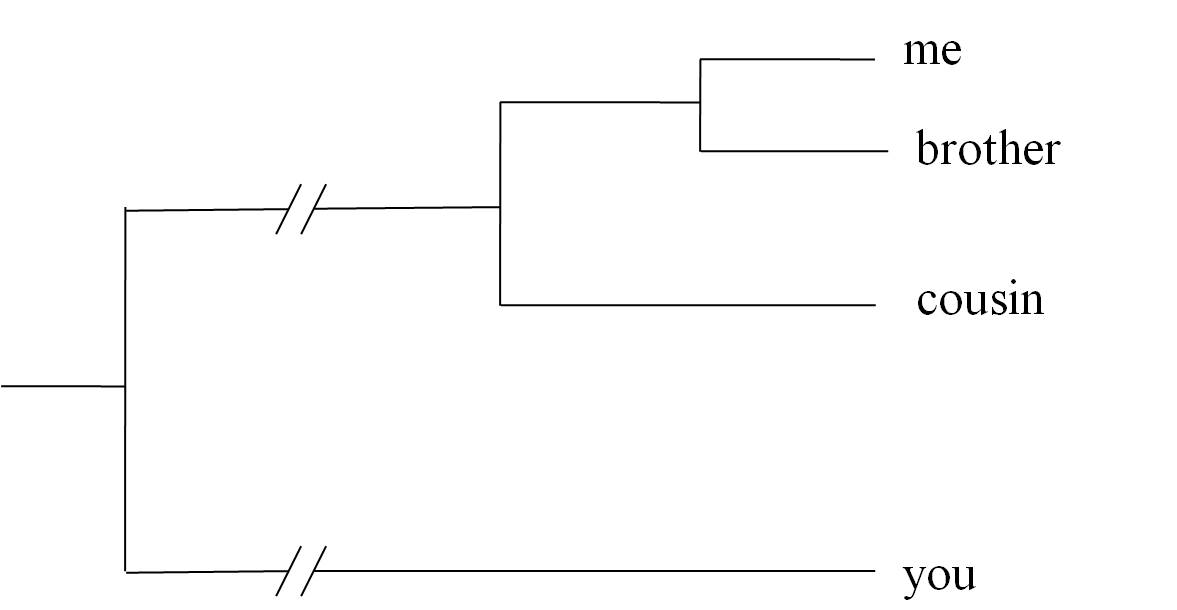 |
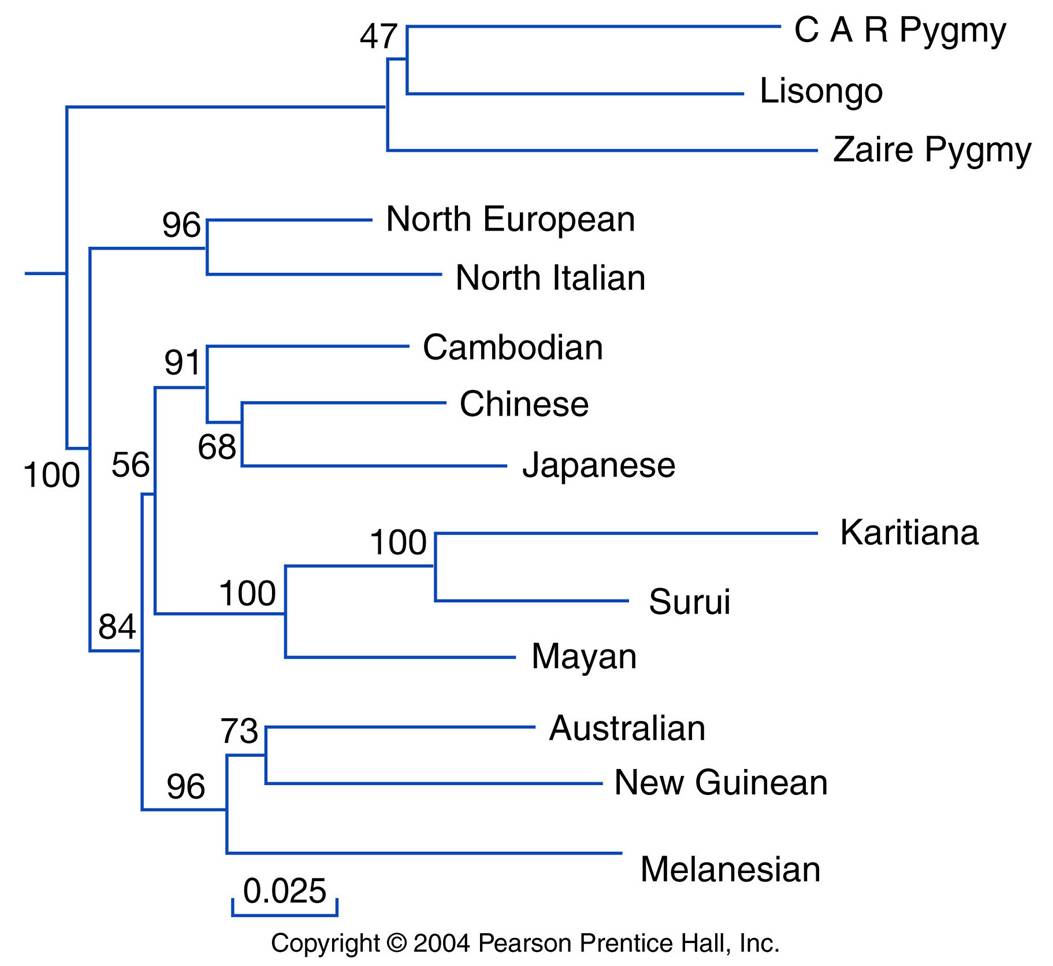 |
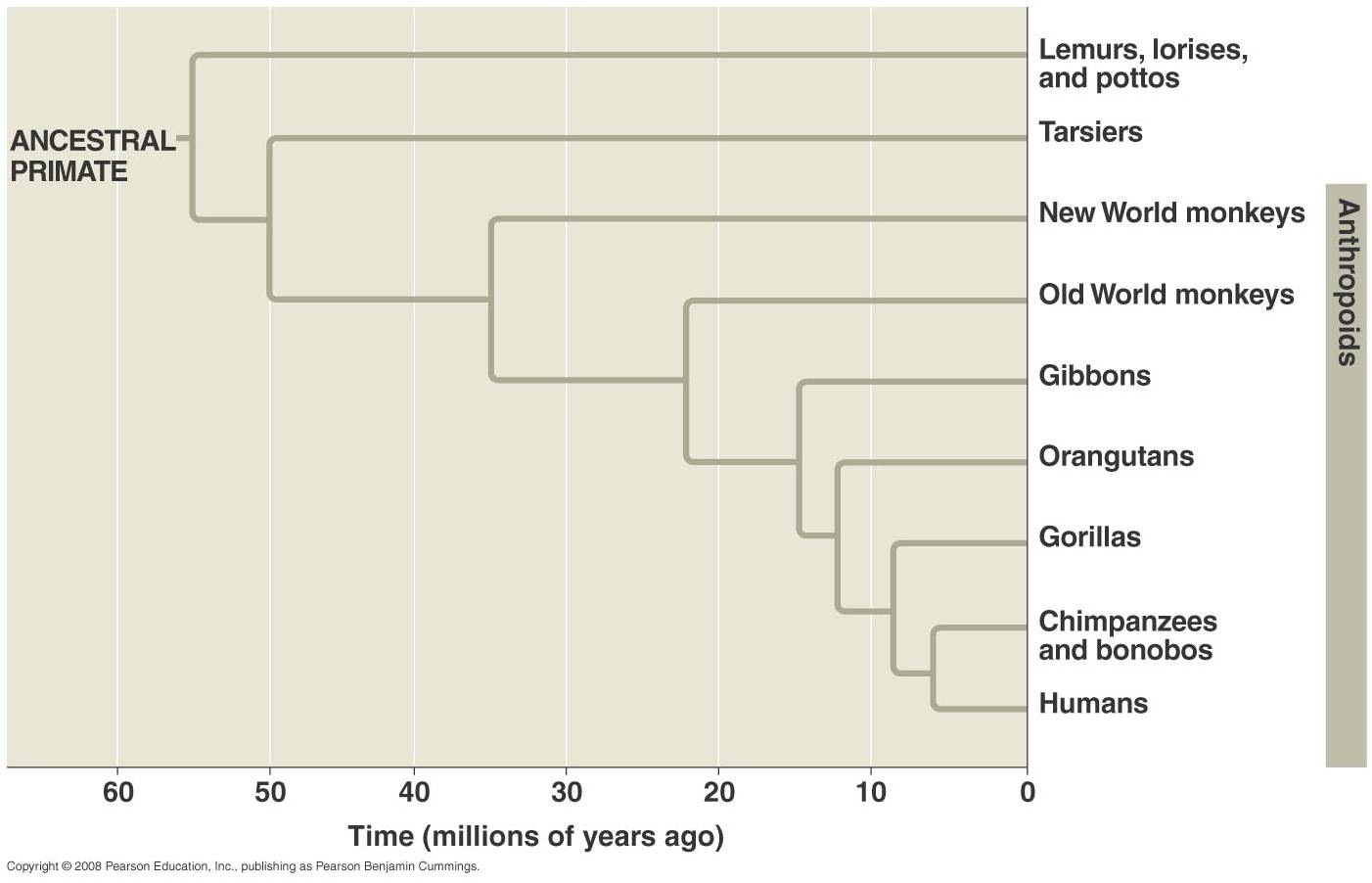 |
Family Genealogy |
Ancestry
of Human Populations |
Phylogeny
of Primates |
- RESPOND TO THE ENVIRONMENT (internal and external) - Living systems all respond to the environment in some way. The nature of the
response often depends upon the scale of organization. For example,
blood vessels in your skin respond to hormones and temperature and dilate when
you are hot - increasing blood flow through surface capillaries to dissipate
metabolic heat (entropy!) to the environment. This is a physiological response.
Organisms can also respond behaviorally - if you are hot, you might
get out of the sun and find some shade or air conditioning! Populations may
respond to the environment, too; a population might shrink in size during drought/heat
stress as mortality rates increase. Because heat-sensitive individuals in the
population would be more likely to die than heat resistant individuals during
this drought, the genetic structure of the population (in this case in terms
of the relative number of genes for heat sensitivity and heat tolerance) of
the population would change, too. this would be a genetic response - or evolution.
- GROW - As a consequence of taking in more
energy and matter than they expel during a particular amount of time, living
systems like cells, organisms, and forests get bigger. Since all living systems
are composed of cells (really another characteristic), growth can occur by increasing
cell size, or by increasing cell number, or both. For reasons we will discuss
later, most cells are small. So, to increase dramatically in size, most living
sysmtes increase the number of cells they have (by cell reprouction).
- ENERGY TRANSFORMATIONS (METABOLISM) – As described above, living systems absorb and transform energy to grow
and to maitain and increase in complexity. These energy transformations are
collectively referred to as "metabolism". As mentioned above, these
transformations are governed by the laws of thermodynamics. The First Law of
Thermodynamics states that "energy is neither created nor destroyed, but
can be transformed". This means that you (as a living system bound by the
first law) can't make new material - like a muscle protein - from NOTHING. You
have to get the carbon, nitrogen, oxygen, and hydrogen atoms from somewhere.
It also means that you can't magically "poof" them together into a
protein. Linking atoms together takes an input of energy, and you have to get
that energy from somewhere, too (cuz if can't be 'created').
So, living systems acquire energy
and matter from their environment, and they simply transform this matter into
new shapes and atomic configurations. These transformations, however, are not
100% efficient - that's the second law described above. So, you can't eat 10
grams of cow muscle protein (meat) and transform that into 10 grams of your
own muscle protein. Although it is pretty similar, the cow muscle proteins must
be broken down into aminoa acids that are reassembled into a new order to create
your muscle protein. So, although these reactions are performed, they are not
produced with 100% efficiency. In fact, mammals are only about 10% efficient
metabolically... so you would be lucky to make 1 gram of muscle from the 10
grams you consumed.
Energy transformations often invovle
breaking material down and then building something new from the parts. 'Catabolic'
reactions break large molecules into their components; 'anabolic' reactions
link small molecules together into larger products. Often, 'catabolic' and 'anabolic'
reactions are linked - so that the energy released by catabolic reactions can
be used to 'drive' the anabolic reactions that are making something.
- EVOLVE - Finally, Life evolves. Populations change over time. One way they change is
to adapt to their environment. Organisms with useful traits reproduce more successfully
than others (Natural Selection); the frequency of these traits change over time
and populations responding to different environmental conditions will diverge
from one another, genetically.
So, these are the characteristics
that all living systems express - either as an emergent property of the populations
to which they belong, or as a reductionistic process of the organisms and cells
and molecules of which they are composed. Biology, then, is the scientific study
of these systems. Phew! That was one long-winded explanation of biology!
B. Life's Unity
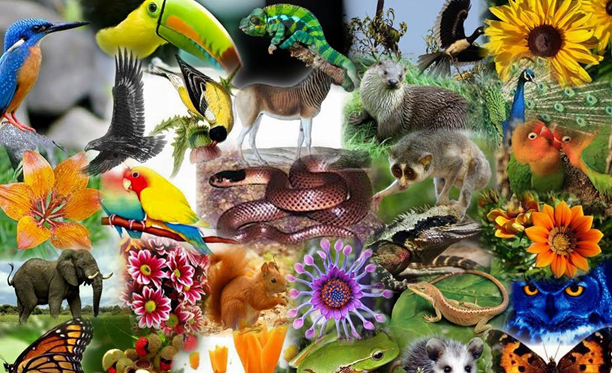
As we have discussed, we are going to focus on cell biology, heredity, evolution and diversity in this course. These concepts are relevant to all biological systems. As such, these concepts form a unifying core of principles that apply to all of life. However, although you might think that ‘diversity’ applies only to species, we see this characteristic across all scales of life, too: from the diversity of proteins in a cell, to the diversity of cells in a multicellular organism, to the diversity of species on a coral reef. Let’s examine these properties of unity and diversity, and see why they are so important.
1. Structural Unity
a. All living systems are made of the same stuff, arranged in largely the same way at a molecular level:
Biomolecules: lipids, carbohydrates, proteins, nucleic acids, in water.
b. All life is cellular – even the largest living things are made of tiny living cells.
Why? Well, first, cells are much different from their environment. In order to maintain these differences and not just 'leak' their stuff out, a barrier is needed that separates the living thing from the non-living environment. This cell membrane is the barrier, and the living 'stuff' is trapped in this cell.
Why are they small? As a three-dimensional object gets larger, the volume increases at a cubic rate of linear dimension. Chemicals are VERY VERY small; they must run into one another to interact. If you have 100 protein molecules in a cell that is 1 cubic um, concentration is 100/nm3. If the cell doubles in length, it’s volume increases to 2 x 2 x 2 = 8 um3. So, to maintain the same concentration of reactants (proteins) a cell that doubles in “size” must make or accumulate 8 times as much stuff! Small cells can increase the concentration of reactants in that small volume more easily, and the concentration of reactants affects reaction rates. But these are just physical constraints. There could be entirely different types of cells that could take advantage of these physical properties.
2. Functional Unity
What is even more remarkable about life is not only the structural similarity—it is the functional similarity: cells work in the same way.
How does life obtain the energy needed to build things? ALL LIVING CELLS (bacteria, plants, animals) break chemical bonds in glucose and make bonds in ATP. They then break these bonds in ATP to make bonds between other molecules (linking amino acids together into proteins, for example). There are a nearly limitless number of other chemical reactions … but all life uses this one. (UNITY).
The primary thing all cells do is make proteins. Some proteins are structural (collagen in your skin, actin and myosin in muscles), but others are enzymes. All chemical reactions in living cells—including those that make lipids, make carbohydrates, make other proteins, and make DNA—require protein enzymes. So, in order to make anything, cells must make particular proteins. And all cells make proteins the same way… they read a ‘recipe’ encoded by the sequence of ATCG in DNA, and a particular sequence of amino acids is put together to make a particular protein. All life. And the process isn’t just the same, the recipe is written in the same language. So, when TTT is read in the DNA of a bacterium, or an oak tree, or your muscle cells, the amino acid proline is placed into the protein sequence. THAT is UNITY.
And cells replicate in the same way to make more cells.
3. Why is life so similar?
All life is so structurally and functionally similar that it is inconceivable that this similarity arose independently and separately. Life replicates. This extraordinary similarity is a consequence of common ancestry… living cells are similar because they inherited genes and characteristics from the same ‘parents’.
B. Life's Unity
II. Diversity
Uh, ok. Well, sure, a blue whale cell and a sponge cell may be nearly indistinguishable in structure and function, but collectively they create organisms (whale and sponge) that are REMARKABLY DIFFERENT. How can we explain this diversity that arises from common ancestry? Differences are produced by divergence, as two populations descended from the same ancestor make their own way in the world, their genes mutate and change, and they adapt and evolve in different ways.
A. Types of Life/Cells
When we look at the diversity of living things, they can be categorized into three major groups:
- bacteria: small, no nucleus.
- archaea: small, no nucleus.
- eukarya: 10x-100x larger; organelles; nucleus.
B. Types of Species
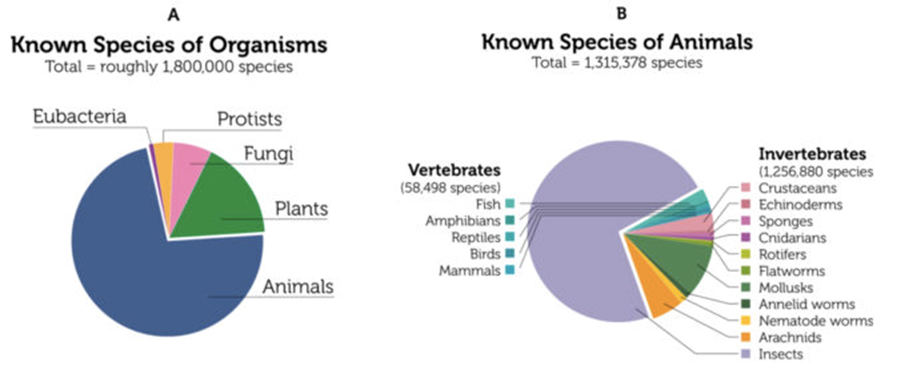 When we look a big closer, at the number of described species in each group, and in different types of eukaryotes, we find an astounding range of different types of life forms; approximately 2 million different species! Now, each of these species is, more or less (barring a small possibility of hybridization between closely related species), a discrete biological entity. Like you! You are a discrete biological entity that has a unique set of genes that no one in the history of the human race will ever have (unless you have an identical twin). Like an individual, a species is a discrete biological entity, too; it has sets of genes which, because it can’t breed with other species, is different and unique. And wow, when we look with the animals (which collectively comprise about 75% of all species of life), rough ¾ of all animal SPECIES (not individuals) are insects. Indeed, insects represent half of all the species of life on the planet. Huh! Why? We will address that later in the course.
When we look a big closer, at the number of described species in each group, and in different types of eukaryotes, we find an astounding range of different types of life forms; approximately 2 million different species! Now, each of these species is, more or less (barring a small possibility of hybridization between closely related species), a discrete biological entity. Like you! You are a discrete biological entity that has a unique set of genes that no one in the history of the human race will ever have (unless you have an identical twin). Like an individual, a species is a discrete biological entity, too; it has sets of genes which, because it can’t breed with other species, is different and unique. And wow, when we look with the animals (which collectively comprise about 75% of all species of life), rough ¾ of all animal SPECIES (not individuals) are insects. Indeed, insects represent half of all the species of life on the planet. Huh! Why? We will address that later in the course.
III. Evolution
A. Overview
The question we have before us, now, is how and why has life become so diverse—why does it come in so many different flavors?? The answer is this: populations of an ancestral species become separated from one another. Genetic differences accumulate, eventually making them so different genetically and biologically that they can’t breed with one another. They have become two different biological entities, that have diverged from their common ancestral species. Some of these differences have arisen just by chance. Other differences have accumulated because they have been adapting to a particular environment. Random differences that accumulate between population have occurred by ‘genetic drift’, whereas differences that accumulated because of a functional benefit --"adaptation"-- have occurred by ‘natural selection’. All these changes, the changes of a descendant from the ancestor, and the divergence between descendants, is evolution: a change in the genetic structure of a population through time.
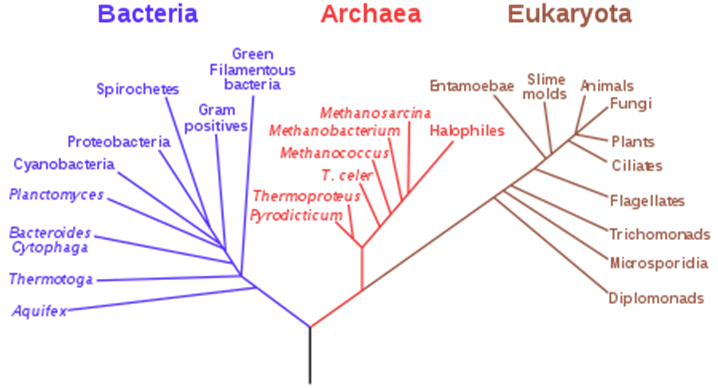 Interestingly, it is because of the unity of life that we can explain the diversity of life. All life works the same way, suggesting a single origin and a common ancestry to all life. (It is exceedingly unlikely that life would have arisen twice, or multiple times, using the same molecules and chemical reactions in the same way, with DNA encoding proteins using the same language. That is so unlikely that we can discount it, for now, while we examine the other hypothesis: that life arose once, and all life on the planet, today is descended from that initial population of living things.) Because all life uses DNA as it’s genetic system (coding for proteins), we can compare the sequence similarity in DNA from different species to determine who is more closely related (shares a more recent common ancestor) with who. For instance, African lions have DNA that is more similar to a house cat than to polar bear. This leads us to hypothesize that the lion and cat are more closely related to one another than either is to the polar bear. Well, when we say "they are more closely related", we mean that they have a more recent common ancestor. (Siblings are more closely related than second cousins, and they share a more recent ancestor with one another (parents) than with second cousins (great-grandparents). So, based on DNA similarity, we can test hypotheses of common ancestry.
Interestingly, it is because of the unity of life that we can explain the diversity of life. All life works the same way, suggesting a single origin and a common ancestry to all life. (It is exceedingly unlikely that life would have arisen twice, or multiple times, using the same molecules and chemical reactions in the same way, with DNA encoding proteins using the same language. That is so unlikely that we can discount it, for now, while we examine the other hypothesis: that life arose once, and all life on the planet, today is descended from that initial population of living things.) Because all life uses DNA as it’s genetic system (coding for proteins), we can compare the sequence similarity in DNA from different species to determine who is more closely related (shares a more recent common ancestor) with who. For instance, African lions have DNA that is more similar to a house cat than to polar bear. This leads us to hypothesize that the lion and cat are more closely related to one another than either is to the polar bear. Well, when we say "they are more closely related", we mean that they have a more recent common ancestor. (Siblings are more closely related than second cousins, and they share a more recent ancestor with one another (parents) than with second cousins (great-grandparents). So, based on DNA similarity, we can test hypotheses of common ancestry.
When Carl Woese did this for bacteria, arachaea, and eukarya species, he found something surprising: Although Archaeans are small, anuceate organisms that supervicially resemble bacteria, they are actually more similar, genetically, to the Eukarya (at least in nuclear genes). And, because mutations in genes occur randomly, differences accumulate at roughly a constant rate; so the amount of genetic difference between two living species can be used to create hypotheses about how long ago the common ancestor lived! Then, we can test these hypotheses with an entirely independent line of evidence… fossils. But before we do test, let’s look at the history of life first, as we know it from the fossil record.
B. The History of Earth and Life
1. Timeline
Go ahead and learn these dates. Tell yourself the story of life’s history. Here it is:
- - about 4.6 billion years ago (bya), a gas cloud that would become our solar system was destabilized – perhaps by a passing star. This set our gas cloud spinning, and it condensed as a disk, with most the mass collapsing towards the center under its own gravitational attraction. Planets aggregated at different distances under their own gravity, sweeping out material at that radius.
- - The early atmosphere formed as the result of gases released by volcanic activity: it probably contained the same gases we see today when rock melts: water vapor, CO, CO2, CH4 (methane), NH3 (ammonia), but no “free” oxygen gas (O2).
- - By 3.8-3.5 bya, we have fossil evidence of life. It probably evolved a bit earlier, but became abundant enough to fossilize. We will go into the details later, but with no oxygen, we can bet that the primary energy-harvesting reactions were photosynthesis (primitive forms that didn’t produce oxygen) and fermentation (anaerobic respiration).
- -by 2.3-2.0 bya, oxygen began to accumulate in the oceans and atmosphere, as a consequence of the evolution of oxygenic photosynthesis. This was toxic to many organisms, but some bacteria evolved new methods of exploiting the oxidative power of oxygen to increase the efficiency of cellular digestion: aerobic respiration evolved (Krebs cycle).
- -1.8 bya (1.6-2.0)-After the evolution of highly efficient, aerobic bacteria, other cells engulfed them without digesting them (endosymbiosis). These cells, powered by 100’s of aerobic bacteria (proto-mitochondria), could be much more energetically active. With a multiplicative amount of energy, they could make more proteins and tolerate an increase in the size of their genomes… leading to more genes that could, through mutation, evolve new proteins more rapidly. These were the first eukaryotes.
- -1.6 bya- shortly thereafter, one lineage of primitive eukaryotes absorbed those bacteria that were photosynthesizing and producing oxygen. These cells, that already had proto-mitochondria (see step, above), and now had proto-chloroplasts, were the first algae. They are colonial, and so may also be considered the first multicellular life forms. http://researchnews.plos.org/2017/03/15/ancient-algae-new-fossils-suggest-plants-might-be-much-older-than-we-thought/
- -0.65 bya (650 mya) – First animals – multicellular with cell differentiation. Spongelike
- ~540-250 mya: Paleozoic Era: Begins with the Cambrian explosion, which sees the radiation of marine invertebrates. Later in this era, we see the evolution of vertebrates and the colonization of land by plants and animals. The Paleozoic ends with the great Permian Extinction, wiping out 90% of all marine species and 70% of all terrestrial species.
- ~250-65 mya: Mesozoic Era – the Age of Dinosaurs, including the evolution of birds and mammals. It ends with the asteroid impact off the Yucatan Peninsula, which caused an ecological winter and caused the second greatest mass extinction event in Earth’s history.
- -65 mya – present: Cenozoic Era, which includes the radiation of modern mammals and the evolution of hominids (4.5 million years ago). The expanse of humans across the planet approximately 40,000 years ago correlates with the extinction of resident large mammals communities. Continued extinctions, caused by habitat conversion beginning in the agricultural revolution (11,000 years ago) and global climate change beginning in the industrial era (1780’s) may mark the next major mass extinction event and delineate a new epoch – the Anthropocene.
2. ‘Transitional’ Fossils
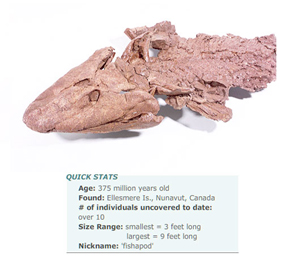 As the major patterns listed above show, there are patterns in the fossil record – everything isn’t present in the oldest strata. Rather, there is an accumulation of complexity over time, and a colonization of new environments by life: from the oceans to land to air. When we look at the fossil record of vertebrates, for instance, we see fish present in strata from 530 mya to the present.
As the major patterns listed above show, there are patterns in the fossil record – everything isn’t present in the oldest strata. Rather, there is an accumulation of complexity over time, and a colonization of new environments by life: from the oceans to land to air. When we look at the fossil record of vertebrates, for instance, we see fish present in strata from 530 mya to the present.
Amphibians, however, are only present in strata from 370 mya to the present. Where did they come from? If life only comes from life, they must have ancestors… but the only vertebrates that could be their ancestors were fish! The hypothesis that amphibians evolved from fish leads to a prediction: there should have been animals along this lineage that were both fish-like and amphibians-like: what we call ‘transitional fossils”. We have found such fossils, just where evolution predicts they should be: after similar fish in the fossil record and before similar amphibians. Tiktaalik, to the right, had front feet but hind fins, and is sometimes called a "fishopod". It dates to 375 mya, right before four-footed amphibians appear in the fossil record.
So, the fossil record is also an incredible body of evidence that tests and supports the hypothesis of common ancestry.
C. Concordance
So, we have these two major ways of making trees: genetics and fossils. If they both have the SAME CAUSE and are truly describing the same phenomenon (common ancestry), then the trees should be largely the same. In other words, transitional fossils should be where genetic analyses of modern species predicts they should be. They are. This is the most compelling proof of the validity of common ancestry.
Think deeply about this: We can take two species, like a lion from the savannahs of Kenya and a white-tailed deer from the forests of Maine, and we can compare their DNA. Based on the number of differences that occur, and the known rate at which these differences accumulate, we can calculate the amount of time needed for this amount of genetic difference to accumulate. In other words, we can calculate when in the past the common ancestor to these species walked the Earth. This ancestral species was obviously neither a lion-like animal nor a deer-like animal; the lineages of carnivores and ungulates (hooved mammals) converge early in the Cenozoic, when primitive placental mammals were radiating. But we have evidence of this in the fossil record, too. And the proof of evolution is that the predictions from lion and deer match the location of these early mammals. Now, why is it that we can compare MOLECULES of species walking around on the planet today, and predict when, in the sedimentary strata of the Earth’s crust, a third separate species was alive? If these organisms were NOT related, there is no way this should work. But, it does. Time and time again.
IV. The Functional Significance of Diversity
A. Cellular Level
In multicellular organisms, different cells perform different functions. This allows them to focus their energy on a limited number of tasks, and perform those tasks more efficiently and productively. It is a “division of labor” that, through specialization, increases efficiency of the system.
What is doubly amazing is that all these different cells, that are performing different tasks because they are reading different genes, are all descended from the same ancestral cell (the zygote). Through development, cell lineages have diverged in FUNCTION by reading different subsets of genes (even though they have all the same genes).
So, through genetic divergence (in terms of what is READ, not what is PRESENT), functional diversity and a division of labor occurs.
B. Ecological Level
Similar species, like those that are recently derived from a common ancestor, are often biologically similar. They may use the same resources in roughly the same way. But because of this, they compete with one another. Those members of each population that use slightly different resources have these resources all to themselves. These organisms do better than those competing with others species, and within that population, there is selection to use this new resource. In this way, species diverge and use different resources. These different species are now more efficiently using the resources in the environment… using the full range of seeds available, not just competing for the same limited range of seeds. This divergence, called ‘niche partitioning’ results in more efficient use of resources in the community. It came about by genetic divergence of these species, adapting to different resources.
At all biological scales, genetic divergence leads to functional divergence and a division of labor which increases the efficiency of the system. As the system adapts and accomodates this diversity, it becomes dependent upon it. The diversity is required for the system to function, because nothing does everything anymore.
Study Questions:
1) Why life is cellular, and why cells are small.
2) Why is making proteins is so fundamental to cell function.
3) When did these things happen: Earth forms, life originates, oxygen accumulates, eukaryotes evolve, Cambrian explosion.
4) How can we use genetic similarity among living species to predict when, in the deep past, their common ancestor lived.
5) What does diversity do for biological systems? Consider both the cellular and ecological levels.
Things to Know (like, without looking at your notes...):
1) Know our definitions of 'biology' , 'science', and 'theory'.
2) Understand the four philosophical approaches used in science. Don't just give a definition; be able to recognize when they are being used.
3) Know how the term 'theory' use in science, and how this differ from its common usage, as in "that is just a theory".
4) Be able to list and explain the characteristics of living things.
5) Understand why 'creationism' and 'intelligent design' are not science.
Study question:
1) Why is the comparative method so useful in biology? Why should we expect things
to be similar?

 Another example is the "camera eye". It is an
extraordinary organ. How does it work? Well, break it down.
There is a retina that responds to visible light by sending neural impulses
to the brain. There is a lens that focuses light on the retina.
There is an iris that regulates the amount of light entering the eye.
There is a cornea that bends the light initially, and there are two gelatinous
"humors" that give the eye shape. WOW! It is a complex system, but
by breaking it down into its component subsystems and learning what they do,
we describe--in part--how an eye works.
Another example is the "camera eye". It is an
extraordinary organ. How does it work? Well, break it down.
There is a retina that responds to visible light by sending neural impulses
to the brain. There is a lens that focuses light on the retina.
There is an iris that regulates the amount of light entering the eye.
There is a cornea that bends the light initially, and there are two gelatinous
"humors" that give the eye shape. WOW! It is a complex system, but
by breaking it down into its component subsystems and learning what they do,
we describe--in part--how an eye works. 






 Interestingly, it is because of the unity of life that we can explain the diversity of life. All life works the same way, suggesting a single origin and a common ancestry to all life. (It is exceedingly unlikely that life would have arisen twice, or multiple times, using the same molecules and chemical reactions in the same way, with DNA encoding proteins using the same language. That is so unlikely that we can discount it, for now, while we examine the other hypothesis: that life arose once, and all life on the planet, today is descended from that initial population of living things.) Because all life uses DNA as it’s genetic system (coding for proteins), we can compare the sequence similarity in DNA from different species to determine who is more closely related (shares a more recent common ancestor) with who. For instance, African lions have DNA that is more similar to a house cat than to polar bear. This leads us to hypothesize that the lion and cat are more closely related to one another than either is to the polar bear. Well, when we say "they are more closely related", we mean that they have a more recent common ancestor. (Siblings are more closely related than second cousins, and they share a more recent ancestor with one another (parents) than with second cousins (great-grandparents). So, based on DNA similarity, we can test hypotheses of common ancestry.
Interestingly, it is because of the unity of life that we can explain the diversity of life. All life works the same way, suggesting a single origin and a common ancestry to all life. (It is exceedingly unlikely that life would have arisen twice, or multiple times, using the same molecules and chemical reactions in the same way, with DNA encoding proteins using the same language. That is so unlikely that we can discount it, for now, while we examine the other hypothesis: that life arose once, and all life on the planet, today is descended from that initial population of living things.) Because all life uses DNA as it’s genetic system (coding for proteins), we can compare the sequence similarity in DNA from different species to determine who is more closely related (shares a more recent common ancestor) with who. For instance, African lions have DNA that is more similar to a house cat than to polar bear. This leads us to hypothesize that the lion and cat are more closely related to one another than either is to the polar bear. Well, when we say "they are more closely related", we mean that they have a more recent common ancestor. (Siblings are more closely related than second cousins, and they share a more recent ancestor with one another (parents) than with second cousins (great-grandparents). So, based on DNA similarity, we can test hypotheses of common ancestry. As the major patterns listed above show, there are patterns in the fossil record – everything isn’t present in the oldest strata. Rather, there is an accumulation of complexity over time, and a colonization of new environments by life: from the oceans to land to air. When we look at the fossil record of vertebrates, for instance, we see fish present in strata from 530 mya to the present.
As the major patterns listed above show, there are patterns in the fossil record – everything isn’t present in the oldest strata. Rather, there is an accumulation of complexity over time, and a colonization of new environments by life: from the oceans to land to air. When we look at the fossil record of vertebrates, for instance, we see fish present in strata from 530 mya to the present.